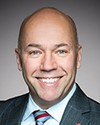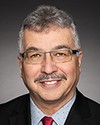Thank you.
I'm Dr. Ed Connors. I'm of Mohawk-Irish ancestry. I'm a band member of Kahnawake Mohawk Territory.
As a psychologist, I've worked across the country in our first nations communities for the past 35 years. In those 35 years I have been intimately involved with the experiences of suicide in our communities.
I'm going to share with you now a synopsis of what I've shared with you in the form of a document that you'll find in your package. I apologize to the French members of the committee that I did not have time to have this fully translated for you because we were just recently notified of the invitation. We will ensure that it will come to you in full translation, as required.
I'm going to make a few comments here with regard to this paper. I'm going to begin with an acknowledgement. Thank you, Louise, for acknowledging the first nations indigenous peoples of this territory and their lands. I will also acknowledge that these are in our territories as well in more, what we call, modern time.
I will begin by giving a comment as an opening, which we do when we open any gathering and when we come together. It's the opening of the thanksgiving prayer. When we begin, we begin in this way, and I think it's significant as an opening to my remarks. What we say when we open in the thanksgiving prayer is that we are now gathered and we see as we gather the cycles of life that continue. As we see those cycles of life as they continue, we recognize that we've been given the duty to live in balance and harmony with each other in all of life. As we do this, we bring our minds together as one, and we give greetings and thanks to each other. Now, as we have done so, we acknowledge that our minds are as one.
I am going to make comments regarding not just our indigenous populations of Canada, because my involvement has been worldwide. I've acknowledged and recognized the similarities in the patterns of suicide globally. The indigenous populations worldwide are at the highest risk of suicide. While indigenous communities worldwide generally present the highest rates of suicide, there are many examples of indigenous populations, such as the Sami people of Norway, and communities in Canada, the B.C. first nations that have been reported by Chandler and Lalonde as having extremely low suicide rates, and in many cases no suicide.
In Canada, high suicide rates range from five to seven times that of suicides among non-indigenous populations. In extreme cases, suicide rates have exceeded over 800 times those of non-indigenous communities. Suicides in indigenous communities globally are overwhelmingly overrepresented among our youth. I draw that to your attention because I think it's an important question and a focus that we need to have about why our youth have such high suicide rates, not just in Canada, but indigenous populations globally.
There are no-to-low suicide rates in many of our communities, and that has been accounted for in many of the studies that have been done. Some of the most recent works show that in those communities we can account largely for the low suicide rates to no suicide rates as being connected to strong self-governance and strong cultural renewal.
Elevated rates of suicide in indigenous communities have also been linked globally to colonization, colonialism, and acculturation. Indigenous world views as expressed through languages, cultures, beliefs, values, and lifestyles have been disrespected, suppressed, and oppressed through the process of colonization.
I share with you at this moment a wampum belt. It is the way that we made treaties in the past, and we made treaties with my ancestors. As I pointed out to you, I am both of indigenous ancestry, Mohawk, and Irish ancestry.
My ancestors came together in the formation of this treaty. This treaty was made in 1613, with the Dutch and the Haudenosaunee, or the Mohawk people. When this treaty was made, it was made to identify the fact that we were of two different world views, two different cultures, two different languages, and different ways of understanding ourselves, the world around us, and all of creation.
It said that we will live together in peace and harmony on this land, but to do so we need to be able to respect each other's cultures, each other's ways of knowing, understanding, and believing, and that we need not only to respect each other's ways, but to recognize that they are equal, that they are not one greater than the other. I believe today that we are faced at this time.... There are many things that tell us today that we're at at time in our history where we can actually come back full circle to this treaty. We can fulfill the vision of our ancestors, of my ancestors and yours.
We talk about today as a time of reconciliation. What is reconciliation? Reconciliation, in many ways, has to do with re-establishing this vision, re-establishing the true relationship of equality and respect.
In our communities today, indigenous world views that have been repressed are now being expressed again and being renewed. As they are being renewed in our communities, and I've seen this happen in many of our communities—as is now being shown within the research—and as that renewal occurs, the rates of self-harm...and the process of healing is taking shape.
The renewal of indigenous world views and associated lifestyles serves to protect against the negative effects stemming from the trauma and losses associated with colonialism. Cultural renewal enables our youth to answer four questions known to be important for healthy development, especially during the period of childhood to early adulthood: Where do I come from? Who am I? Why am I here? Where am I going? This knowledge also relates to recent insights provided through the First Nations Mental Wellness Continuum Framework. It identifies meaning, purpose, belonging, and hope as core concepts underlying the state of wellness or health within our people.
First nations communities have known that cultural renewal is primary to the recovery of healthy indigenous people's families and communities. This has been the core of our effective healing programs for many years. Twenty-seven years ago, I was part of the development of the sacred circle, providing a way of life within the Ojibway Tribal Family Services in Treaty 3, northwestern Ontario.
This was one of the earliest examples of cultural renewal within our communities as a process of healing. It was the first time that we really spoke to the experiences of life promotion, as opposed to suicide prevention. It was the first time that we supported cultural renewal and healthy community development. It was discontinued, and this is an important point, and I'll close on this note. That work that was done, and many of the pieces of work that we've done in the past that we've proven to be effective, were discontinued across the nation. Programs that were focusing on this at one point in time, which were once federally funded, moved from federal funding to provincial funding. When that happened, there was a change from what we called family support programs and cultural renewal to a process of child protection and child welfare agencies. When that happened, we moved from the process of cultural renewal and the healing of our communities to where we are today.
I challenge you in your thinking about this to consider that we know what works. We have seen what works, and we have had many example of that. We know this within our communities.
I hope that we are able to gain the support of your committee as we continue to come together in the process of reconciliation and of healing within our communities.
Thank you.




